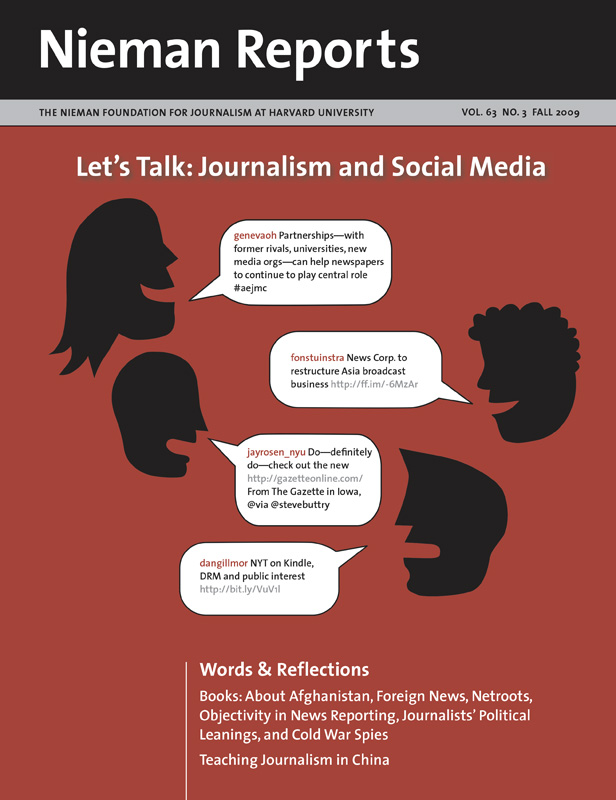UPDATE
The guide to covering pandemic flu is now available:
http://coveringflu.org/Three years ago, the Nieman Foundation convened a first-of-its-kind conference for journalists, experts in infectious diseases and world, national and local public health officials to explore how to cover a potential pandemic. Then the concern was avian flu, and the gathering’s purpose was to achieve the following:
- Improve journalists’ understanding of the dynamics of a health crisis—from the threats it poses to efforts needed to cope.
- Engage journalists, scientists and public health officials in dialogue about their intersecting roles and purpose.
- Examine how newsrooms and news organizations should prepare to handle such coverage and keep their own operations going.
- Consider the crucial role journalism plays—from preparedness to response to recovery.
This effort echoes the intent of other conferences organized by the foundation in which we identify an issue pertinent to journalists—one not well understood in newsrooms or not receiving adequate coverage—then bring together experts in the field for several days of learning and dialogue. Information from these conferences is then widely distributed to other journalists.
Nieman Reports published a wealth of material from this conference in its Spring 2007 edition. Then, a special issue, focused solely on this topic, was distributed to journalists. We’ve updated and expanded that report, and the new guide to covering a pandemic will be available in early fall on the Nieman Foundation’s Web site. Stefanie Friedhoff, a 2001 Nieman Fellow and the foundation’s special projects manager, organized the 2006 conference and is editor of the guide. “The idea behind this guide is to provide an accessible, solid resource in case the H1N1 strain, or any new or known flu strain, strikes in more deadly form,” she says.
While swine flu, so far, seems to have lulled us into a belief that a pandemic doesn’t always spell disaster, health officials recognize that flu pandemics typically arrive in waves; as winter arrives in the Northern Hemisphere, it is possible a more lethal strain of the flu—and a more dangerous pandemic—might be with us. Physicians and scientists are learning much about this virus, yet coverage of their findings—and reporting about the public health guidance based on them—is scant. After an initial flurry of “crisis” reporting, coverage of this evolving story, with the exception of occasional pieces about summer camp flu protocols and new recommendations about school closure policies, has diminished considerably.
With layoffs of health, medical and science reporters (and entire science and health units) happening in U.S. newsrooms, fewer journalists with expertise to coordinate coverage are left. Will this story reside with reporters who bring little scientific knowledge or actual experience in covering an outbreak? Our reliance on having journalists who are prepared to dive in with informed questions, probe deeply and report with authority might now rest on shakier ground. The challenge will be amplified if H1N1 is transformed into a pandemic with more widespread severe illness and higher mortality.
One feature of this story makes pandemic flu coverage unique: Journalists will report on what is happening, but also will be potential carriers. “What do we know about protecting ourselves when we travel to a hot zone?” asks Friedhoff. “How do we make sure we don’t carry the virus back to our colleagues? How many newsrooms have thought about how to cover a pandemic when a large number of staff are sick or told to stay home for public health reasons?’’
During a pandemic, the news media become a primary source of public communication. The press will want to assure its independence, yet public health officials will certainly ask for cooperation in getting specific messages and information to the public. Journalists need to be well informed about flu viruses in general so they will be prepared to do their work efficiently and effectively with this one. Realizing which of the “experts” is truly to be trusted as a source is essential at a time when public panic is likely to be setting in.
The journalist’s guide the Nieman Foundation has created contains the accumulated wisdom of those reporters experienced in covering infectious diseases. Valuable insights surface in excerpts from conversations with public health officials. For those new to the subject, the guide offers a quick introduction to key questions about influenza and pandemics along with a glossary and explanations of basic terms and roadmaps through some local and national preparedness efforts as well as international coordination during an outbreak. It’s a resource for story ideas, links to excellent online resources, and questions any reporter is going to want to ask.


